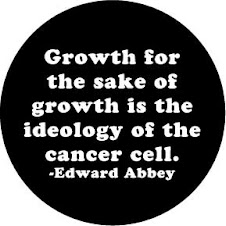
If the population continues to grow as predicted, something I don't personally believe is possible, we will have nine billion humans, give or take half a billion, by 2050, mostly in cities. How will we feed them all? It is obvious the current methods of food transport are unsustainable and we would need 10 billion more hectares of farmland to do the job. So would we cut down all the remaining forest, the only effective carbon sequestration we have and are likely to have in the next fifty years, and plow under an area the size of Brazil with all the attendant water pollution, loss of diversity, and global warming effects of current industrial farming? I don't think so. Even if we hold the population at current levels cities need to become sustainable just as a households do. This means local food for one thing, closing the nutrient cycle by recycling waste for another.

I don't tend to favor high tech solutions but this urban farming concept, a 30 story tower that could feed 50,000 people is all organic, provides local food, recycles waste, and provides jobs is attractive. I wonder, could it be retrofitted to appropriately situated towers already in existence? Even if purpose built it would certainly be a better allocation of resources than some multinational headquarters full of computers. Here's a more in depth article on this concept over at Plenty magazine.




.jpg)







2 comments:
A complimentary solution to vertical farming is sub-acre farming. A sub-acre farming method now being practiced throughout the U.S. and Canada is called SPIN-Farming. SPIN stands for S-mall P-lot IN-tensive, and it makes it possible to earn significant income from growing vegetables on land bases under an acre in size. SPIN farmers utilize relay cropping to increase yield and achieve good economic returns by growing only the most profitable food crops tailored to local markets. SPIN's farming techniques are not, in themselves, breakthrough. What is novel is the way a SPIN farm business is run. SPIN provides everything you'd expect from a good franchise: a business plan, marketing advice, and a detailed day-to-day workflow. In standardizing the system and creating a reproducible process it really isn't any different from McDonalds. So by offering a non-technical, easy-to-understand and inexpensive-to-implement farming system, it allows many more people to farm, wherever they live, as long as there are nearby markets to support them, and it removes the two big barriers to entry – sizeable acreage and significant start-up capital.
So while vertical farming will still take some time to get off the ground, sub-are farming is already showing how agriculture can be integrated into the built environment in an economically viable manner. This is not subsistence farming a la Cuba. This is recasting farming as a small business in cities and towns, "right sizing" agriculture for an urbanized century and making local food production a viable business proposition once again.
Thanks for the comment Roxanne,
I had heard of SPIN farming but had not yet researched it. Thanks for the impetus to do so. From your description I agree it would be complimentary.
Post a Comment